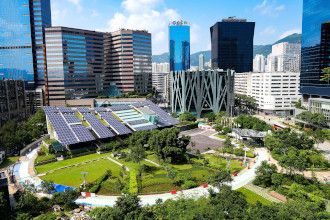By Matthew Mausner – What would a sustainable city be, and how would it fit in our society, and into our ecology? Mega-cities have become perhaps the defining feature of global civilization in the last 30 years. Not so long ago, New York, Tokyo, and Mexico City were the only megalopolis, over 15 million people. Now there are dozens of massive urban conglomerations, at least 35 metropolitan areas over 15 million, and for the first time ever, more than half of the world’s population lives in urban areas. How can we live sustainably in such a situation?
Cities Can Be Sustainable
On the surface, it would appear that living in cities is the most unsustainable way to live. For example, Los Angeles takes most of the water from a huge area of the American southwest, and almost everyone there owns and commutes by car. Concrete and asphalt for roads, parking lots, and suburbia covers over soils, farms, forests, and wetlands expanding outward from almost every growing city on earth.
Yet, a multi disciplinary approach can discover many ways that these trends can be a net positive for sustainability. Dense cities like New York and Hong Kong have a high proportion of people who live in large apartment buildings with centralized heating and cooling, and commute by public transportation or on foot. As a result, the average New York city resident has less environmental impact and only one tenth the carbon footprint of the average American.
Many of the world’s largest and most important cities are on the coast and are highly vulnerable to possible rises in sea level as a result of climate change. Already cities including Jakarta, Amsterdam, New Orleans, New York and Lagos have had to address these issues, and are already facing issues like subsidence (the ground itself shifting or becoming unstable), escalating damage from storms, and the inexorable pressure from the rising seas on their seawalls and levees. Despite research and ecological engineering towards controlling carbon emissions, green technology progress development, and policies like the green new deal, there may simply be limits difficult to overcome on what can be done to make cities on the sea sustainable. Sustainable cities and society as a whole may have to face the future impossibility of urban areas being located on the coastlines as we know them.
The Development of Sustainable Cities
For better or worse, the country of the Netherlands (literally ‘the low countries’) has been coping with subsidence for many centuries, with elaborate attempts to hold back the effects of the North Sea on their small and highly vulnerable country. They are thus famous for their polder land- land reclaimed from below sea level via their iconic windmills pumping and proverbial dikes. This history has led them to take the lead in many innovative developments related to sustainability. They have always built their main cities- Amsterdam, Rotterdam, the Hague- as ports with large and conscious modifications of the shorelines and canals, with a high degree of readiness and seawalls to cope with floods and changing sea levels. Since their terrible famine in the winter of 1944-45, the Dutch have led the world in productive greenhouse agriculture. More and more of their housing is structured with goals of sustainability in mind, with solar power, access for bikes, and direct government support and subsidies for development that accrue higher costs in the service of these longer term goals.
According to The Nature of Cities, “A recent study in Cape Town, South Africa, found that sacred sites functioned as places for rich and meaningful spiritual experiences, and that aesthetic appreciation was correlated with the species richness of woody plants. In many cities, parks and grounds owned by religious organizations are important green infrastructure features.” Religious communities and sites have much to offer when it comes to enhancing urban sustainability.
Interdisciplinary Interest in Sustainable Cities
More and more disciplines, from urban planning and architecture to sociology, environmental studies, ecological engineering, and artificial intelligence, are all focusing on the impact of our current cities and on helping redesign them for the future. This is manifesting in new multi disciplinary approaches to design, materials, integrated infrastructure, ‘smart cities‘, and other forms of research, and publications in a wide range of academic journals. “Sustainable cities and society”, or SCS is an international journal focusing on fundamental and applied research aimed at designing, understanding, and promoting environmentally sustainable and socially resilient cities. Cities and society SCS is an international multi disciplinary research journal. There is no other international journal focusing on fundamental and applied research about sustainable cities and society, but there is not yet evidence that their focus has made their articles a highly regarded nor relevant guide to policy.
Even more mainstream media like the Economist have aggregated these ideas about the potential gains from making cities denser, smarter, and more sustainable, and have estimated that it could add trillions of dollars to the world’s economy while simultaneously lowering pollution and other negative indicators. Fundamental and applied research could help this succeed.
But are sustainable cities possible to develop? There probably are no sustainable cities by any of the many criteria used in these ivory tower academic journals. Their standards for what would make cities and society sustainable are likely unattainable, as they include both zero impact and also high levels of technology, with ‘smart cities’-style artificial intelligence measuring and controlling every impact factor. In reality cities and society are organic systems, with urban development that happens naturally in response to human needs for housing, access to work and goods and services, support, and mitigation and adaptation to their challenges of living in an overpopulated society in their country.
No abstract analysis or scientific management of development guided by data or by the cross cutting environmental guidance of the hallowed researchers at a journal focused on sustainable cities and society can actually reshape our cities into efficient sustainable cities. Such utopian thinking might cause terrible economic or even climate changes if put into practice. However, the usual counter argument is that in the long run we have no choice, because if cities and society are not sustainable, eventually we will see a collapse. In other words, we can do this the easy way or the hard way.
Environmental Development in Sustainable Cities and Society
Smart cities monitoring the most relevant measures of urban data can identify efficient economic related growth. While communities in society might not appreciate the reduction in their consumption guided by an article in a journal of environmental management, or their buildings becoming abstract systems to support the idealistic goals of scholars of climate or carbon science, they are clearly not in touch with the efficiency possible if only they could afford these ideal housing buildings.
In order to genuinely achieve the kind of urban management envisioned in the journal articles’ mode of comprehending the attainable, a reduction in population might be the best solution to achieving genuinely sustainable cities. While such an impact factor could be seen as undesirable for those whose consumerist lifestyles do not easily fit into environmental society managed by the scientific development envisioned by the research in the articles in the journal, it’s more likely that they do not yet appreciate the benefits of living under the management of the goals of sustainable cities and society; monitoring, education and clearer presentation of the data are the factors most likely to aid in successful compliance.
The Benefits of Sustainable Cities
Megacities or their agglomeration, a megalopolis, is a more and more common feature of the world, especially places like the new cities in China. On the plus side, denser arrangements with newer and greener housing and public transportation, infrastructure built with pedestrian and bicycle mobility in mind, and integrated composting and waste management, improves our chances that such an urbanized future has more hope.
Urban planning is a maturing field with many journals of its own. Public transportation is better, faster, and has higher coverage and greater convenience. Air quality improves with more people using public transportation and there is less air pollution. Green spaces are built into the plans of the city from the beginning. Shifting to renewable energy and energy efficient existing infrastructure decreases the carbon footprint. Pedestrian friendly neighborhood centers with genuine community, as Jane Jacobs long recommended, improves the social fabric with many benefits for the health of the people as a whole. Local styles of architecture help people feel a connection to their home and culture.
Resilient, Sustainable Cities
One way to think about this set of issues is towards ‘resilience’, not simply sustainable as it used to be defined. Applied research aimed at understanding the tradeoffs inherently incurred by inevitable development aims to encourage these modes of building sustainable cities and society. There needs to be mitigation and adaptation to increasing impacts, with an understanding that there are both known and unknown risks and likely consequences to continued growth of human civilization and population.
Dense sustainable cities are necessary if we are to maintain enough space for the rest of nature and the rest of the web of life to continue to flourish alongside our urbanized environment. And recognizing that our technologies and cultural preferences will change and evolve in unpredictable ways means being ready and flexible to accommodate the natural environment into our future as well. We need to have plans for the things that aren’t planned, both in terms of disasters generated by the natural world such as earthquakes, generated by human error like deforestation and climate change, and by other things that we can’t even predict. That’s the way to make cities truly sustainable.
Awards for Sustainable Cities
The “Sustainable Cities And Human Settlements Awards” (SCAHSA) is an annual global prize awarded by Global Forum on Human Settlements (GFHS) and supported by UNEP for the past fifteen years. It focuses on promoting the mission of GFHS and encourages the implementation of the 2015 Sustainable Development Goals by encouraging awardees through recognizing their incredible progress and their substantial experience over the course of implementing more sustainable goals.
The Global Green City Award for 2020 went to Glasgow for their efforts in becoming a sustainable city. “The city was ranked top for categories including planning, transport, low carbon and energy efficiency, transportation, buildings, open spaces and the economy.” From being one of the first leaders in the Industrial Revolution, Glasgow is today a Global example of a leader in the Green Revolution. Glasgow is definitely deserving of the honor of hosting the COP26 this November 2021!
* Featured image source
Curious to learn more? Follow this link to learn about the Three Pillars of Sustainability.





